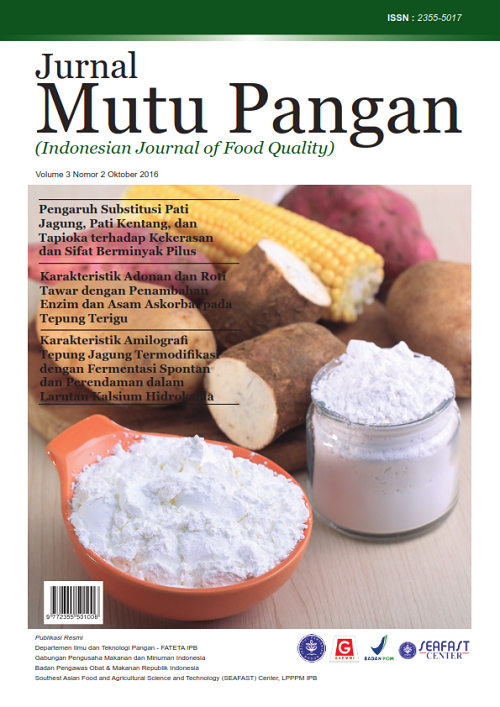Efektivitas Program Pembinaan Industri Rumah Tangga Sari Buah di Kota Depok
Abstract
The main factor that causes food safety problem in home industries is lack of good manu-facturing practices (GMP) implementation. The objective of this research were to evaluate the imple-mentation of GMP, identify coliform and Escherichia coli contamination in fruit juices, evaluate effec-tiveness of fostering assisted program based on implementation of GMP criteria, and compose the recommendation of fostering assisted program for fruit juice home industries in Depok. The fostering assisted program have been given for certain periode to lower level home industries showed the decrease of unconformities factors for industries D, E, F and increase of industries level. The effectiveness scores of fostering assisted program provided for industry D and E were 1, and F was 0.83; indicated the good achievement. There were not found coliform and Escherichia coli in juice samples from industries D, E, and F (starfruit juice samples), whereas there found coliform in guava juice samples from industry F (5.2 x 102 APM/mL) and the result of Escherichia coli test was negative before fostering assisted program. After fostering assisted program, the result of coliform test to guava juice samples of F was negative.
Downloads
References
[BPOM] Badan Pengawas Obat dan Makanan. 2013. La-poran Tahunan Badan Pengawas Obat dan Pangan RI. Http://www.pom.go.id.
Feng P, Weagant SD, Grant MA, Burkhardt W. 2013. Bac-teriological Analytical Manual. U.S. Food and Drug Administration. Http://www.fda.gov.
Haileselassie M, Taddele H, Adhana K. 2012. Sources of contamination of raw and ready to eat foods and their public health risks in Mekelle City, Ethiopia. J of Food and Agriculture Science 2(2): 20-29.
Hossain MN, Fakruddin M, Islam MN. 2011. Effect of chemical additives on the shelf life of tomato juice. American J of Food Technol 6(10): 914-923.
Humayun A, Sourav S, Saha P, Singh JP, Chaturvedi N, Ramalingam C. 2013. The effect of the citric and malic acid on the storage stability and sensory parameters in lemonade. J of Pharmaceutical, Biological and Chemi-cal Sci 4(4): 1671-1679.
Kasim A. 1993. Pengukuran Efektivitas dalam Organisasi. Lembaga Penerbit Fakultas Ekonomi UI, Jakarta.
Khoer M. 2015. Ratusan Industri Pangan di Depok Tak Berizin. Http://www.bisnis.com.
Khomsan A. 2000. Teknik Pengukuran Pengetahuan Gizi. Departemen Gizi Masyarakat dan Sumberdaya Kelu-arga, Fakultas Pertanian, IPB, Bogor.
Ogodo AC, Ugbogu OC, Ekeleme UG, Nwachukwu NO. 2016. Microbial quality of commercially packed fruit juices in South-East Nigeria. J of Basic and Applied Res2(3): 240-245.
Olorunjuwon BO, Temitope BK, Muibat FO, Afolabi O. 2014. Microbiological quality of some locally-pro-duced fruit juices in Ogun State, South Werstern Nige-ria. J of Microbiol Res 2(1): 1-8.
Patel KT, Chotai NP. 2011. Documentation and records: harmonized GMP requirements. J of Young Pharm 3(2): 138-150.
Reddi SGDNL, Kumar RN, Balakrishna N, Rao VS. 2015. Microbiological quality of street vended fruit juices in Hyderabad, India and their association between food safety knowledge and practices of fruit juice vendors. Int J Curr Microbiol App Sci 4(1): 970-982.
Yunus SP, Umboh JML, Pinontoan O. 2015. Hubungan personal higiene dan fasilitas sanitasi dengan kontami-nasi Escherichia coli pada makanan di rumah makan padang Kota Manado dan Kota Bitung. J Ilmu Kesehatan Masyarakat Unsrat 5(2): 210-220.
[WHO] World Health Organization. 2008. Children's Health and the Environment. WHO Training Package for the Health Sector.

















